

Housing Has a New Face
New report by Harvard’s Joint Center
for Housing Studies points to larger role for women and minorities in
housing’s future

by Kermit
Baker, PhD, Hon. AIA,
Chief Economist
Despite job losses in the rest of the economy, housing had another record-breaking year in 2003. Home sales, single-family housing starts, residential fixed investment, homeownership rates, mortgage originations, refinances, and home prices all reached new peaks. The only weak spots were the uneven rental market and the depressed manufactured-housing sector.
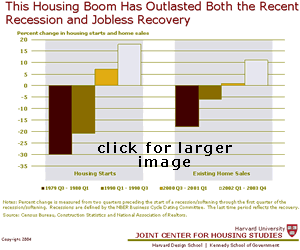 This
housing boom has been both longer and more broadly based than previous
expansions. Construction activity has remained strong in most states and
real house prices have climbed in nearly all metropolitan areas. Rents
have increased in more areas than they have decreased, and industry indicators
suggest that rents are stabilizing in some locations that have seen recent
declines.
This
housing boom has been both longer and more broadly based than previous
expansions. Construction activity has remained strong in most states and
real house prices have climbed in nearly all metropolitan areas. Rents
have increased in more areas than they have decreased, and industry indicators
suggest that rents are stabilizing in some locations that have seen recent
declines.
With the economic recovery under way, the question now is whether housing will achieve a soft landing in which house prices, sales, and new construction ease rather than drop off sharply. Several factors favor this possible outcome. Housing construction appears to be in line with long-run demand, and a strengthening economy should support house prices. In addition, changes in the housing finance system have made markets more resilient and better able to adjust quickly to interest-rate movements.
Although refinancing activity would drop off significantly if interest rates rise even gradually, construction would probably hold near its current pace and house price inflation would be moderate rather than turn negative. If job growth falters or interest rates spike, however, housing could be in for a rougher ride.
Uninterrupted growth
The housing boom has outlasted an international finance crisis in 1998,
an economic recession in 2001, and job losses in 2002–’03.
Throughout most of this period, low interest rates kept housing markets
thriving as home prices and sales continued to climb. Rising home values
in turn generated wealth effects that helped to sustain consumer spending.
In fact, the wealth effects related to home-price appreciation, realized
capital gains, and heavy home equity borrowing appear to have contributed
more than one-quarter of the growth in personal consumption in both 2002
and 2003.
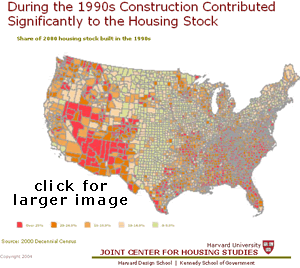 Residential
construction has been on the rise for most of the last 12 years, adding
significantly to the housing stocks in both metropolitan and nonmetropolitan
areas—particularly in the South and West. While large metro areas
such as Atlanta and Las Vegas have seen spectacular increases in new construction,
the rate of growth in many small and midsize metros exceeded 25 percent.
Residential
construction has been on the rise for most of the last 12 years, adding
significantly to the housing stocks in both metropolitan and nonmetropolitan
areas—particularly in the South and West. While large metro areas
such as Atlanta and Las Vegas have seen spectacular increases in new construction,
the rate of growth in many small and midsize metros exceeded 25 percent.
Despite growing concern over the pace of development, housing construction over the next 10 years is likely to exceed that over the last decade. The Census Bureau’s newly revised population estimates imply that household growth from 2005–15 will be as much as 1.1–2.0 million more than the Joint Center for Housing Studies previously projected. Add to that the growing demand for second homes and replacements of units lost from the stock, and the total number of homes built in 2005–’15 could reach 18.5–19.5 million units. This compares with 16.4 million homes added in the 1990s.
In the meantime, house prices in many areas of the country have risen considerably faster than household incomes. This rapid appreciation has raised concerns that housing is headed for a crash. Although more locations are now at greater risk of a home-price decline than a year or two ago, a sharp correction is unlikely unless the economy unexpectedly contracts. Sharply higher interest rates would, however, quickly erode affordability for homebuyers. In that case, home prices would come under pressure unless employment and income growth were strong enough to offset the rate increases.
The first line of defense that potential homebuyers can take against rising rates is to choose mortgages that adjust annually or hybrid mortgages that have fixed rates for a set number of years before adjusting. While these maneuvers blunt the short-run impact of higher rates, they do expose owners to higher monthly payments if interest rates continue to climb.
Demand transformed
The changing demographic structure of the population is reshaping housing
demand. Immigration has been, and will continue to be, an important driver.
Immigrants have accounted for more than a third of household growth since
the 1990s—adding not only directly to the number of households,
but also indirectly as their U.S.-born children begin to live on their
own. Although recent immigrants have lower homeownership rates than native-born
Americans of comparable races, ethnicities, and ages, with time, many
foreign-born households eventually join the ranks of owners.
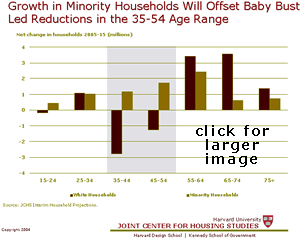 Owing
to immigration and higher rates of natural increase, the minority share
of households increased from 17 percent in 1980 to 26 percent in 2000
and will likely reach about 34 percent by 2020. Minority household growth
over the next 10 years will add significantly to the growth in household
heads aged 55 to 74 and help to offset losses of white household heads
aged 35 to 54 as the baby bust cohort reaches middle age.
Owing
to immigration and higher rates of natural increase, the minority share
of households increased from 17 percent in 1980 to 26 percent in 2000
and will likely reach about 34 percent by 2020. Minority household growth
over the next 10 years will add significantly to the growth in household
heads aged 55 to 74 and help to offset losses of white household heads
aged 35 to 54 as the baby bust cohort reaches middle age.
This will only add to the already important contributions that minorities have made to housing demand in recent years. In particular, without the rapid growth in minorities, the number of renter households would have fallen during the 1990s. Instead, the renter population increased modestly and the minority share of renter households surged from 31 percent to 39 percent over the decade. In addition to keeping rental demand from sagging, minorities also accounted for fully two out of every five net new homeowners from 1994 to 2003. Despite these strong gains, though, minority homeownership rates still lag those of whites by nearly 25 percentage points. Narrowing this persistent gap remains a challenge for both the government and the mortgage finance industry.
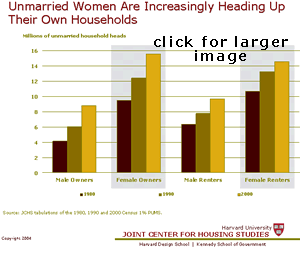 Meanwhile,
social and economic trends have given women a more powerful presence in
housing markets. Between 1980 and 2000, the number of households headed
by unmarried women increased by almost 10 million. Over the same period,
the median contribution of wives’ earnings to dual-earner households
rose from 30 percent to 37 percent. As a result, unmarried women now head
a larger share of households and married women make larger contributions
to household income than ever before.
Meanwhile,
social and economic trends have given women a more powerful presence in
housing markets. Between 1980 and 2000, the number of households headed
by unmarried women increased by almost 10 million. Over the same period,
the median contribution of wives’ earnings to dual-earner households
rose from 30 percent to 37 percent. As a result, unmarried women now head
a larger share of households and married women make larger contributions
to household income than ever before.
Although both women and minorities make up increasing shares of middle-income households, they are still over-represented in the lowest-income category. The incidence of housing problems is therefore higher among minorities than whites and among unmarried women than unmarried men of comparable ages.
Housing challenges
Although the overwhelming majority of Americans are well housed, nearly
a third of all households spend 30 percent or more of their incomes on
housing and 13 percent spend 50 percent or more. In addition to widespread
affordability problems, crowding is on the increase, some 2.5–3.5
million people are homeless at some point in a given year, and nearly
2 million households still live in severely inadequate units.
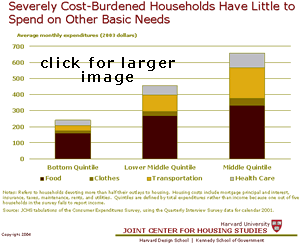 Not
surprisingly, housing challenges are most severe among persons at the
bottom of the income distribution. Fully half of lowest-income households
spend at least 50 percent of their incomes on housing. Severely cost-burdened
households in the bottom quintile by expenditures have little left over
to pay for other basic necessities, spending just $161 on average each
month on food and $34 on health care. By comparison, households in the
bottom expense quintile that devote less than 20 percent of their budgets
to housing managed to spend $80 more a month on food and $49 more on health
care on average.
Not
surprisingly, housing challenges are most severe among persons at the
bottom of the income distribution. Fully half of lowest-income households
spend at least 50 percent of their incomes on housing. Severely cost-burdened
households in the bottom quintile by expenditures have little left over
to pay for other basic necessities, spending just $161 on average each
month on food and $34 on health care. By comparison, households in the
bottom expense quintile that devote less than 20 percent of their budgets
to housing managed to spend $80 more a month on food and $49 more on health
care on average.
Unfortunately, affordability pressures are unlikely to ease. Many of the low-wage jobs created by the economy do not pay enough for a household to afford (at 30 percent of income) even a modest one-bedroom rental anywhere in the country. Similarly, retirement incomes are so meager that many seniors face heavy housing cost burdens on top of escalating health-care costs.
Adding to the pressures on low-income households is the cost of supplying new affordable housing. Restrictive regulations and public resistance to high-density development make it difficult to replace or add lower-cost units. Prospects for additional income supports or housing subsidies are equally bleak. As the federal deficit balloons, the calls to cut spending on social and housing programs are growing even as the demand for and costs of these programs continue to escalate.
Copyright 2004 The American Institute of Architects.
All rights reserved. Home Page ![]()
![]()
 |
||
| This article is summarized from the recently published State of the Nation’s Housing: 2004 by the Joint Center for Housing Studies at Harvard University. Free copies of the report in PDF format are available at the center’s Web site. Printed copies are available for $15 per copy prepaid to the Joint Center, 1033 Massachusetts Ave., 5th floor, Cambridge, MA 02138, attention: publications. In addition to serving as the AIA’s chief economist, Kermit Baker is the senior research fellow at the Joint Center for Housing Studies and the project director of the center’s Remodeling Futures Program.
|
||